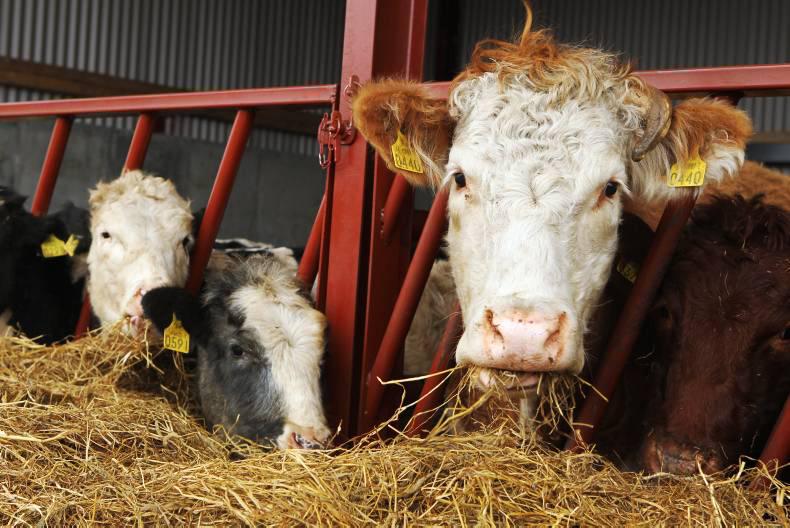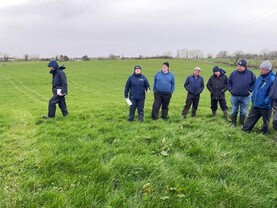The characteristics of modern grass silages vary greatly from that made 20 years ago. The current approach involves aiming to grow the crop from a clean sward with a low winter residual grass cover, applying a maximum of 100 units of nitrogen (N) including slurry for first-cut silage and ensiling the crop at a minimum of 22% dry matter.
This approach varies greatly from a time when grass silage was often grown from high winter grass covers, receiving excessive amounts of N and ensiled in many situations at dry matters as low as 17% and 18%. This resulted in poorly preserved silages of low digestibility and ultimately poor animal performance.
It is important to remember that when grass is ensiled in either a pit or bale, some losses are inevitable. The challenge is to minimise these losses in the field, at fermentation and at feedout.
Farmers at the Teagasc open day in Grange Research Centre in 2014 were informed that even with good management, 16% to 23% of grass harvested does not make it to the animal’s mouth.
Furthermore, the digestibility of ingested silage can be up to 7% lower than the digestibility of the harvested sward.
It is these facts that have led to a renewed interest in the use of grass silage additives as part of making quality, high D-value silage.
Most silage additives now cost less than in the past. This fact, coupled with the trend towards higher dry matter silages, makes it more economical than before to apply an additive at ensiling. The increased dry matters mean that less grass has to be treated.
Many farmers are taking surplus grass from paddocks in bales and the material tends to be of high quality. For a silage bale weighing 750kg, it will generally cost less than €1 to treat each bale with an additive.
Return
With many additives showing milk yield responses of up to +1 litre/cow/day, this provides a return in the order of 7:1 on the money invested in silage additive for a lactating dairy cow, even at the current low milk price.
There is also ample data showing milk protein, liveweight gain and dry matter ensiling benefits from the use of reputable silage additives.
Quality silage starts with quality grass, cut at the correct growth stage to optimise digestibility and yield.
The aim of preservation is to retain silage quality as close as possible to the grass being harvested and to avoid unnecessary ensiling losses.
Grass protein is made up of long chains of bound amino acids, which is true protein. During the fermentation process, these chains of amino acids are broken down, thus reducing its feed value.
Furthermore, excessive heat is created within the silage and the energy used to create this heat comes from the ensiled grass.
The role of quality silage additives is to speed up the fermentation process to ensure more protein and more energy is retained and available to livestock at feedout.
The chemical analysis of silage cannot tell the route or rate of fermentation, but only shows the end point of analysis.
Higher animal performance
A cooler and faster fermentation will retain the nutrients in the silage, preserving it closer to the quality of the grass being ensiled and give higher animal performance, as more protein will be retained as true bound protein and there will be less losses from heat.
According to Seamus O’Slatarra, technical director at Agritech: “Modern-day silage additives are, in general, technically far superior than the early days of inoculants.
“The advent of new strains of bacteria, such as Lactobacillus Paracasei, provide a whole new opportunity in terms of speedier fermentation and, more importantly, increased animal performance from grass silage,” he said.
He advises farmers that additives should be purchased based on their independent proven ability to increase animal performance and accelerate fermentation.
“With quotas no longer a restricting factor and the current cost of grass silage now a very significant outlay on all farms, it is vitally important that grass silage reaches the animal in as near as possible to the quality and volume of the grass ensiled.
“The application of a quality silage additive can play a significant role in achieving this aim,” he added.
Read more
To read the full Baled Silage Focus supplement click here.
The characteristics of modern grass silages vary greatly from that made 20 years ago. The current approach involves aiming to grow the crop from a clean sward with a low winter residual grass cover, applying a maximum of 100 units of nitrogen (N) including slurry for first-cut silage and ensiling the crop at a minimum of 22% dry matter.
This approach varies greatly from a time when grass silage was often grown from high winter grass covers, receiving excessive amounts of N and ensiled in many situations at dry matters as low as 17% and 18%. This resulted in poorly preserved silages of low digestibility and ultimately poor animal performance.
It is important to remember that when grass is ensiled in either a pit or bale, some losses are inevitable. The challenge is to minimise these losses in the field, at fermentation and at feedout.
Farmers at the Teagasc open day in Grange Research Centre in 2014 were informed that even with good management, 16% to 23% of grass harvested does not make it to the animal’s mouth.
Furthermore, the digestibility of ingested silage can be up to 7% lower than the digestibility of the harvested sward.
It is these facts that have led to a renewed interest in the use of grass silage additives as part of making quality, high D-value silage.
Most silage additives now cost less than in the past. This fact, coupled with the trend towards higher dry matter silages, makes it more economical than before to apply an additive at ensiling. The increased dry matters mean that less grass has to be treated.
Many farmers are taking surplus grass from paddocks in bales and the material tends to be of high quality. For a silage bale weighing 750kg, it will generally cost less than €1 to treat each bale with an additive.
Return
With many additives showing milk yield responses of up to +1 litre/cow/day, this provides a return in the order of 7:1 on the money invested in silage additive for a lactating dairy cow, even at the current low milk price.
There is also ample data showing milk protein, liveweight gain and dry matter ensiling benefits from the use of reputable silage additives.
Quality silage starts with quality grass, cut at the correct growth stage to optimise digestibility and yield.
The aim of preservation is to retain silage quality as close as possible to the grass being harvested and to avoid unnecessary ensiling losses.
Grass protein is made up of long chains of bound amino acids, which is true protein. During the fermentation process, these chains of amino acids are broken down, thus reducing its feed value.
Furthermore, excessive heat is created within the silage and the energy used to create this heat comes from the ensiled grass.
The role of quality silage additives is to speed up the fermentation process to ensure more protein and more energy is retained and available to livestock at feedout.
The chemical analysis of silage cannot tell the route or rate of fermentation, but only shows the end point of analysis.
Higher animal performance
A cooler and faster fermentation will retain the nutrients in the silage, preserving it closer to the quality of the grass being ensiled and give higher animal performance, as more protein will be retained as true bound protein and there will be less losses from heat.
According to Seamus O’Slatarra, technical director at Agritech: “Modern-day silage additives are, in general, technically far superior than the early days of inoculants.
“The advent of new strains of bacteria, such as Lactobacillus Paracasei, provide a whole new opportunity in terms of speedier fermentation and, more importantly, increased animal performance from grass silage,” he said.
He advises farmers that additives should be purchased based on their independent proven ability to increase animal performance and accelerate fermentation.
“With quotas no longer a restricting factor and the current cost of grass silage now a very significant outlay on all farms, it is vitally important that grass silage reaches the animal in as near as possible to the quality and volume of the grass ensiled.
“The application of a quality silage additive can play a significant role in achieving this aim,” he added.
Read more
To read the full Baled Silage Focus supplement click here.






 This is a subscriber-only article
This is a subscriber-only article










SHARING OPTIONS: